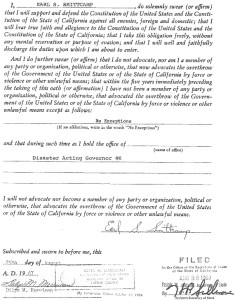Most people are familiar with the idea of a line of succession; a series of people who would take over in the event that an official is killed, disabled, or is temporarily absent or unavailable to hold their office. For example, when President Kennedy was assassinated and when President Nixon resigned, their Vice Presidents assumed the empty office.
In California, the line of succession for the Governor starts with the Lieutenant Governor, who sits in the #2 position. In our state, Lieutenant Governors have succeeded to the Governorship seven times (most recently in 1953). After the Lt. Governor, the position transfers (in order) to the Senate President pro Tem, Speaker of the Assembly, Secretary of State, Attorney General, Treasurer, Controller, Superintendent of Public Instruction, Insurance Commissioner, and Chair of the Board of Equalization.

But who takes over if these constitutional officers are killed or missing in a major disaster or nuclear attack? It’s a name you’re not likely to recognize: Earl S. Smittcamp, a 92-year-old frozen food businessman from the farming town of Clovis.
The line of succession beyond these constitutional officers is dictated by an obscure law written in the 1950s at the height of cold war tension amid concerns about an impending nuclear war between the United States and USSR. The law, which remains in effect today as Government Code section 12050-53, requires the Governor to appoint up to seven Disaster Acting Governors, in a ranked order, to assume control of the state in the event that the rest of the civilian government for the state was killed or missing.
After the passage of the law in 1958, Governor Pat Brown appointed his Disaster Acting Governors. Of the seven appointed in 1959, the only one resigned before the end of Brown’s term was Thomas C. Lynch. According to newspaper reports, Lynch resigned as Disaster Acting Governor #1 in order to run for Attorney General in 1966, which he won.

After the 1966 election, Ronald Reagan moved into the Governor’s office and soon appointed a new group of seven new Disaster Governors. In addition to Smittcamp (designated as “Disaster Acting Governor #6”), other six others were Carlyle Reed (#1), Victor Lundy (#2), R. Gwin Follis (#3), Y. Frank Freeman (#4), Virgil Pinkley (#5), and A. W. Bramwell (#7). Two years later, Reagan appointed Robert L. Vickers to fill the vacancy created when Freeman died in 1969.
Since the appointment of Vickers in 1969, no new Disaster Governors were appointed and time has gradually taken its toll on Reagan’s seven appointees; Lundy and Bramwell died in the 1970s, with Follis and Pinkley following in the early 1990s. Carlyle Reed died in 1999, leaving only Vickers and Smittcamp rounding out the line of succession.
After more than a decade as the highest-ranked Disaster Governor, Vickers died earlier this year at age 92. Now, after nearly half a century, Smittcamp serves on as California’s last remaining Doomsday Governor.

Leave a Reply
You must be logged in to post a comment.